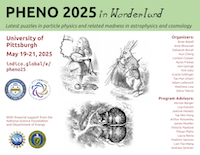Speaker
Description
A favored scenario for axions to be dark matter is for them to form a cosmic string network
that subsequently decays, allowing for a tight link between the axion mass and relic abundance.
We discuss an example in which the axion is protected from quantum gravity effects that would
spoil its ability to solve the strong CP problem: namely a string theoretic axion arising from gauge
symmetry in warped extra dimensions. Axion strings arise following the first-order Randall-Sundrum
compactification phase transition, forming at the junctions of three bubbles during percolation.
Their tensions are at the low scale associated with the warp factor, and are parametrically smaller
than the usual field-theory axion strings, relative to the scale of their decay constant. Simulations of
string network formation by this mechanism must be carried out to see whether the axion mass-relic
density relation depends on the new parameters in the theory

